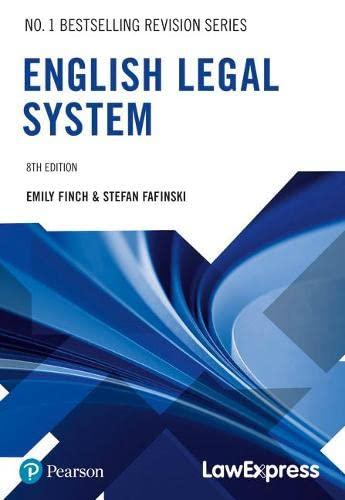Question
Question 1 (10 marks) Read paragraphs 183-196 of the copy of the WorkChoices Case (2006) under the Assessment 2 information on the LMS page. These
Question 1 (10 marks)
Read paragraphs 183-196 of the copy of the WorkChoices Case (2006) under the Assessment 2 information on the LMS page. These paragraphs are extracts from the majority judgment of Chief Justice Gleeson and Justices Gummow, Hayne, Heydon and Crennan. Answer the question below.
The plaintiffs in the case argued that the interpretation of s 51(xx) should be limited in a way that would make the WorkChoices legislation invalid. They made this argument on a number of grounds. In paragraph 189 of the judgment, the majority judges describe two of these grounds as: 'arguments about social or political utility' and arguments that 'explicitly or implicitly invoked notions of federal balance'.
- What problems did the judges identify with both kinds of argument?
- Why did they consider these arguments to be unhelpful in constitutional interpretation?
Question 2 (10 marks)
Read paragraphs 526-553 of the copy of the WorkChoices Case (2006) under the Assessment 2 information on the LMS page. These paragraphs are extracts from the dissenting judgment of Justice Kirby in the case. Answer the question below. In his dissenting judgment, Justice Kirby strongly disagrees with the majority opinion. In the extract you have been asked to read, he explains his reasoning on issues that he calls 'testing propositions by outcomes' (para 541) and 'the federal issue' (para 545).
- What reasons does Kirby J give for taking a different view to the majority in relation to constitutional interpretation on these questions?
- What does Kirby J consider will be the outcome for Australia's federal structure of upholding the validity of the WorkChoices legislation?
TASK: MAKE CONSTITUTIONAL LAW ARGUMENTS
Question 3 (15 marks)
- Relying on your analysis above, and any other case law and secondary material that is relevant and helpful, answer the following question: 5 The majority judgment and Kirby J's judgment in the WorkChoices case present two different approaches to constitutional interpretation. In using a range of interpretive principles and take different factors into account, the judgments illustrate how varied approaches to constitutional interpretation can lead to different outcomes. Which approach or approaches to interpretation do you prefer and why? It will help you to answer this question if you use your answers to Questions 1 and 2 to identify principles of constitutional interpretation used in the two judgments and consider the impact of those principles on constitutional decision-making in general. In your answer, you may discuss approaches to constitutional interpretation that do not appear in the extracts you have been asked to read as long as your discussion of these approaches is directed at answering Question 3.
Step by Step Solution
There are 3 Steps involved in it
Step: 1

Get Instant Access to Expert-Tailored Solutions
See step-by-step solutions with expert insights and AI powered tools for academic success
Step: 2

Step: 3

Ace Your Homework with AI
Get the answers you need in no time with our AI-driven, step-by-step assistance
Get Started


